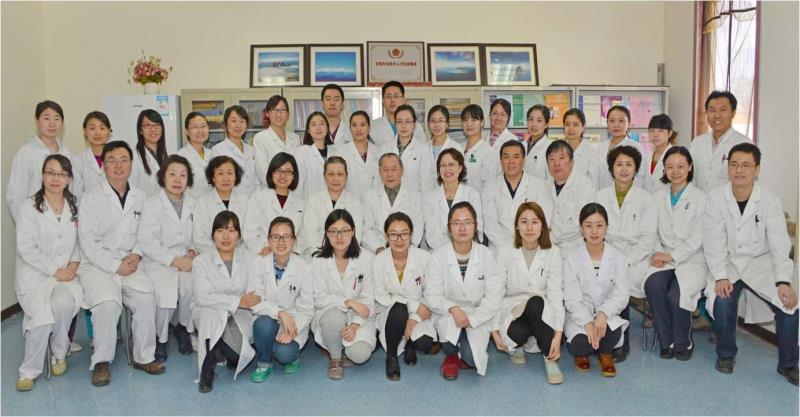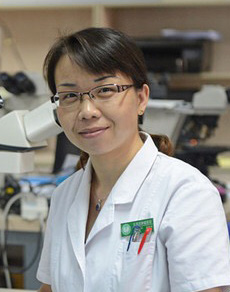The Department of Breast Pathology and Research Lab was established in 1985, it is the State Key Lab of Breast Cancer Research and the only specialized pathology department that devoted to breast pathological diagnosis and research in China. This department is the leading member of the National Breast Cancer Pathology Cooperation Institution of China. This department has 24 staff members including 6 senior technical titles (Professor Xilin Fu, Professor Fu Li, Professor Yun Niu, Professor Dong Yin, Archiater Yu Fan, Archiater Ronggang Lang),3 senior vice technical titles (Associate Professor Feng Gu, Associate Researcher Xiumin Ding, Associate Professor, Xiaojing Guo ),4 intermediate technical titles:(Technologist-In-Charge Ajuan Lv, Lecturer Yiling Yang, Lecturer Xiaolong Qian, Lecturer Wei Zhang). In 2010, we did diagnosis about 8334 cases, in which including 2205 surgical specimens of outpatients, 2600 radical mastectomy specimens of inpatients, besides that there are outer court’s and other specimens. We did 3200 frozen-section examinations, 1696 core needle biopsies (CNB), and so on.

Main Field and Technical Character
1) Pathologic examination and diagnosis: the department insists on standardization, systematize and series. In every year, the routine pathologic diagnosis mere established to 4000 cases with breast lesions and the intra-operative frozen sections diagnosis were performed to 1200 ones and oncogene ER、and PgR status to 3000 cases with breast cancer were determined by means of immunohistochemistry. Fifty cases of whole organ section examination were made. Five hundereds consultation on difficult cases were recepted from all over the country.
2) Scientific research: The department emphasis on early diagnosis and prediction about metastasis of breast cancer. The department has taken charge of or participated in 25 Research Projects of Nation, City and University and has won 6 ones Scientific and Technical Progress Prizes of Tianjin, as well as has possessed 11 new techniques filling in the gaps of the field. As first author, 40 academic papers were published in international or national journals. As the editor or participant edited and translated 16 books. Sixteen of graduated students were trained in the department.
3) Technical Characters: The department in our country are that a) the whole organ section is used to diagnosis to multi-centricity of breast cancer, occult breast cancer and Paget’s Disease.
b) anti-human breast cancer monoclone antibody M4G3 is used to confirm origin of the primary focus of the metastastic carcinoma in lymph-node.
4) Advanced equipment: The department has imported an automatic immunohistochemical staining machine from USA recently. The equipment is the first one in Tianjin and is only possessed by few hospitals in other city. It makes the immunohistochemical technique achieving international standard and it is characterized by large quantity checking samples and getting results more quickly. It can be used not only in determining ER, PR and the many kinds of oncogene production protein, but also in molecular biological experiments such as ISH, FISH, and so on.
Immunohistochemistry Laboratory
Immunohistochemistry or IHC refers to the process of detecting antigens (e.g., proteins) in cells of a tissue section by exploiting the principle of antibodies binding specifically to antigens in tumor tissues. Immunohistochemistry Laboratory, founded in 1995, consists of three professionals. Immunohistochemistry has been mainly used for the ER, PR, HER2, P53, and ki-67detection of routine breast cancers; pathological special cases and consultation cases. A total number of 4,500 cases were performed per year, including 3,000 breast cancer cases. The lab has Ventana Medical Systems. The lab has also organized the training Course about the advance of breast cancer IHC to help the development of pathologist in other hospitals.
FISH Laboratory
FISH laboratory, founded in 2008, in charged of Dr. Yang. FISH has been mainly used for HER2 testing of breast cancers. A total number of 500 cases were performed from our cases and consultation cases per year.
The human epidermal growth factor receptor 2 (HER2) gene is amplified in 20% to 25% of human breast cancers. HER-2 is a tumor marker for aggressive disease and to measure response to targeted therapies, such as trastuzumab (Herceptin; Genentech, South San Francisco, CA) and lapatinib (GlaxoSmithKline, London, United Kingdom). Evaluation of HER-2 status should consider the costs of treatment as well as the potential benefits of therapy. And the cost of the diagnostic test is minimal compared with the cost of the medications. More accurate assignment of patients to treatment more than offsets the costs of erroneously treating women whose breast cancers lack HER-2 amplification. The FDA has approved two immunohistochemical (IHC) assay methods and fluorescent in situ hybridization (FISH) assays for this purpose. IHC is associated with a number of both false-negative and false-positive results that are related to a number of critical factors including preanalytic tissue processing, lack of antibodies that function consistently in variably processed FFPE tissue, increased staining related to antigen retrieval techniques, and subjective scoring of membrane staining. FISH is more reproducible between central and peripheral laboratories than IHC, and FISH is more accurate for HER-2 measurement and more strongly correlated with responsiveness to trastuzumab or lapatinib treatment.
CD-DST
Individual chemotherapy has become more and more important in the clinical treatment of tumor because of the complex mechanisms of tumor development. At present, anti-tumor drug sensitivity test could be a useful way to realize the Individual chemotherapy and CD-DST (Collagen Gel Droplet Embedded Culture-Drug Sensitivity Test) is one of the most developed drug sensitivity test system, it can be used for almost all kinds of solid tumor. In CD-DST, the primary tumor cells are cultured in the droplet of collagen to simulate the 3D microenvironment of tumor cells in human body. Compared with other system, CD-DST has several special characters. It has high success rate and need small cell number to do the test (only 3000cells/droplet); By using the image analysis software, we could omit the contamination of fibroblast cells and only check the response of tumor cells to the anti-tumor drug, so the results of CD-DST highly correlated with the clinical response. In one word, CD-DST is a useful way to help the doctors to choice the right drugs for the right patients
Developable Plan
The department will deepen the research on the pathogeny mechanism, the metastatic and molecular mechanism of breast cancer, so as to adapt to the development of 21 century and the wonderful establishment of Breast Cancer Prevention and Therapy Center of Tianjin in China. The molecular pathology laboratory, cytobiology laboratory and immunopathology laboratory and so on will be set up in the department. The department will be a base for scientific research and talent training and will undertake the senior foundational research projects such as national ones and provincial ones. From these, the department will reach the high level of scientific research, clinical medicine and education. The department is also put on collaborative studies with other countries and link up to the international researches as soon as possible.
